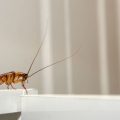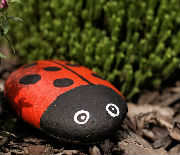
A pantry infestation can be both frustrating and concerning. The biscuit beetle is among the pesky intruders that often enter our homes. It is common for these little insects to infest stored food items, especially biscuits, grains, and cereals.
You can, however, get rid of the biscuit beetles in your kitchen and prevent future infestations if you have the proper knowledge and take proactive measures.
Throughout this article, we’ll explore biscuit beetle behaviour, whether they pose a risk to your health and practical tips for eliminating and preventing a secondary biscuit bug infestation.
Table of Contents
How to identify biscuit beetle
The biscuit or the drugstore beetle, scientifically known as Stegobium paniceum, belongs to the family Anobiidae. The biscuit beetle is called because it especially likes biscuits, grains, cereals, and other dry foods.
Beetles of this species are usually identified by their reddish-brown colour and 2-3 millimetres long body. They also have two pairs of wings, with the front wings known as elytra. Wings are typically used for short-distance flights to find new food sources or mates. The biscuit beetle, however, is not a strong flyer, preferring instead to crawl.
The biscuit beetle is known for reproducing rapidly and causing significant damage to food supplies if not controlled. With their faeces and cast skins, they can easily contaminate food.
Keeping your pantry pest-free requires understanding their behaviour and taking preventative measures.
Are biscuit beetles harmful to humans?
The good news is that biscuit beetles do not bite humans or animals. They can, however, cause contamination and damage to stored food items, so their presence is more of a nuisance. As a general rule, food contaminated with biscuit beetles or their larvae should not be eaten. Biscuit beetles can introduce insect parts, eggs, and excrement into your food, which is unsightly and unhygienic. Additionally, insect proteins can cause allergies.
A different pest or insect may cause bites or discomfort, so it is recommended to consult a pest professional for identification and treatment.
What is the life cycle of a biscuit beetle?
As with other beetles, this species goes through the following life stages: egg, larva, pupa, and, finally, adult. Temperature, moisture and the amount of food affect the development speed of this insect.
The drugstore beetles lay their eggs in hard, starchy foods such as dried plants, biscuits and papier mache. Depending on environmental conditions and available food sources, a single female biscuit beetle can lay anywhere from 20 to 100 eggs. Larvae tunnel into the food to feed and grow. Adults emerge from round exit holes covered in gritty frass.
The entire life cycle of a biscuit beetle lasts 7 months. This beetle can reproduce up to four generations per year in warm countries.
Why do you get biscuit beetles?
A variety of factors contribute to biscuit beetle infestations in particular areas. A biscuit beetle is typically attracted to the following:
- Food source: The biscuit beetle prefers dry, stored food items such as biscuits, grains, cereals, nuts, dried fruits, and spices. These food sources provide nourishment as well as a suitable breeding environment.
- Humidity & moisture: High humidity can attract biscuit beetles, creating a favourable environment for reproduction and survival. Moisture-deteriorating food products can also cause infestations.
- Warmth: The biscuit beetle thrives in warm environments. Their life cycle and activity can increase with higher temperatures, making infestations more severe.
- Food spills: Spills and improper food storage can attract biscuit beetles. Their keen sense of smell can detect even the tiniest trace of food residue, so they are attracted to areas where food is readily available.
- Lack of sanitation: Inadequate cleaning and sanitation can create a welcoming environment for biscuit beetles in the kitchen or pantry. Debris, spills, and contaminated storage areas can be insect breeding grounds.
How to get rid of biscuit beetles
You probably already wonder: “Well, what can I do about these biscuit beetles?”The best way to eliminate them and other pantry pests is to take a systematic approach that involves identifying the infested areas, eliminating the current infestation, and taking preventive measures.
The following steps can help you effectively eliminate biscuit beetles:
- Inspect: Take the time to thoroughly inspect your pantry, kitchen cabinets, and other areas where you store food products. Look for evidence of an infestation, such as damaged packaging, webbing, larvae, or adults. Pay close attention to stored grains, cereals, spices, dried fruits, and biscuits.
- Remove infested items: If a food item shows signs of infestation, discard it immediately. To prevent the spread of beetles outside your home, seal them in a plastic bag.
- Clean the infested areas: All food items should be removed from affected areas, and the shelves, cabinets, and pantry should be thoroughly cleaned and disinfected. Remove any remaining larvae, pupae, or beetles with a vacuum cleaner: clean cracks, crevices, and corners where biscuit beetles may hide. Remove the vacuum bag from the canister and dispose of it outside.
- Wipe down surfaces: Wipe shelves, cabinets, and other surfaces with soap and water or a mild household cleaner. If any residues or food remains that may attract beetles, this will help erase them.
- Repackaging non-infested items: Check all remaining food items for signs of infestation. Dispense any items that show signs of beetles or contamination. Transfer non-infested items to airtight glass, metal, or heavy-duty plastic containers. Some people prefer to additionally keep high-risk items in the fridge as a precautionary measure.
- Track and trap beetles: Place a pheromone or sticky trap near the infested areas. In these traps, attractants lure adult beetles and capture them.
- Make a homemade spray to repel biscuit beetles: You can deter biscuit beetles (drugstore beetles) from infesting your pantry or food storage areas by making a homemade repellent spray. Mix one cup of white vinegar with water in a bowl or container. By disrupting their sense of smell, vinegar deters beetles. It is known that essential oils like peppermint, eucalyptus, lavender, and cedarwood are insect-repellent, so add 10-15 drops of your favourite essential oil. Pour the repellent spray into a spray bottle and shake well, then spray it around your pantry or food storage areas where you’ve seen biscuit beetles. Spray along the edges and corners of shelves, cracks, and crevices where the beetles might hide or lay their eggs.
- A professional pest control service: You may need to hire a professional pest control service if the infestation persists or if the problem is severe or recurring. Pest technicians can effectively eliminate the infestation by providing targeted treatments and guidance.
What can I do to prevent biscuit beetles?
To prevent biscuit beetle infestations, storing food items in airtight containers is important, maintaining cleanliness in the kitchen and pantry, regularly inspecting and discarding expired or infested food products, and ensuring proper ventilation and moisture control in storage areas.
Proper storage practices will prevent future infestations. The following guidelines can help:
- Keeping food in airtight containers will prevent beetles from accessing it.
- Maintain freshness by checking expiration dates on packaged foods.
- Maintain a clean and organised pantry by regularly removing crumbs and spills.
- Before you store susceptible items like flour, grains, and nuts, freeze or refrigerate them for a few days to kill any potential pests.
Takeaways
- The biscuit beetle, also known as the drugstore beetle, infests stored food items like biscuits, grains, and cereals;
- It takes a biscuit beetle seven months to complete its life cycle;
- Food items should be stored in airtight containers to prevent biscuit beetle infestations;
- There is no risk of humans or animals being bitten by biscuit beetles;










Leave a Reply